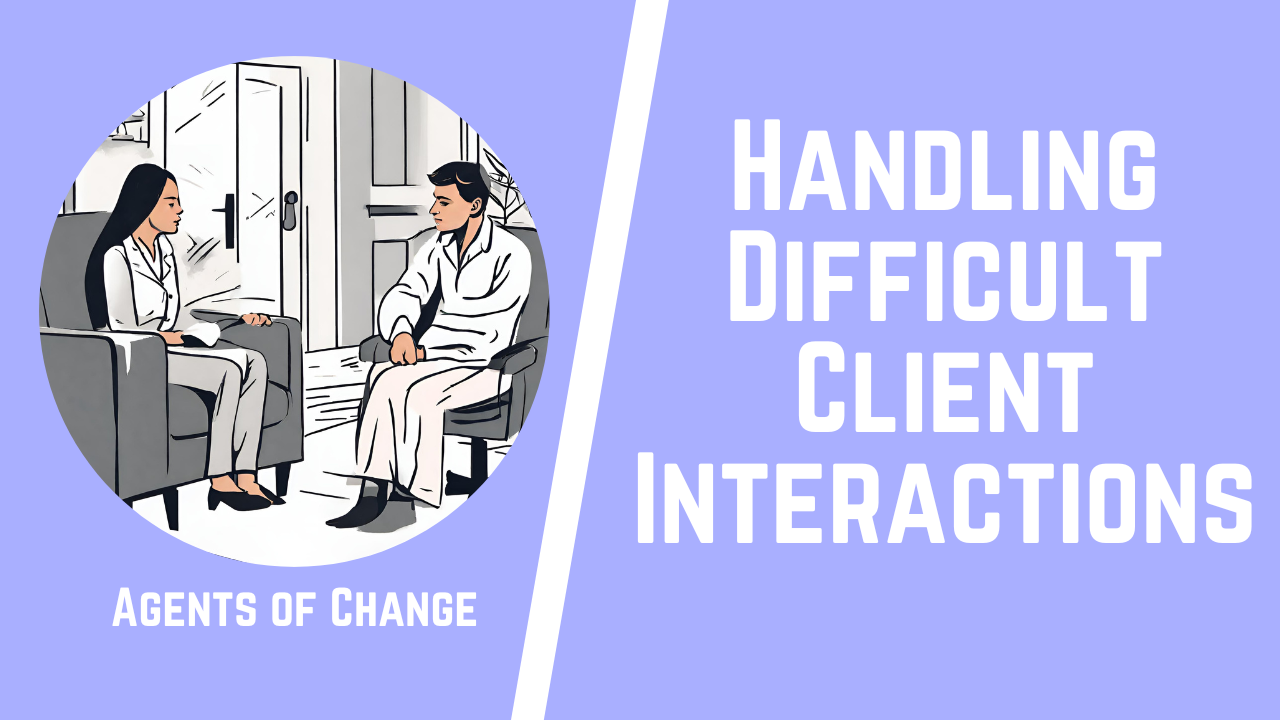Navigating client interactions in Social Work can be as complex as it is critical, particularly when those interactions are challenging or strained. Whether you’re a seasoned professional or a newcomer preparing for the ASWB exam, mastering the art of handling difficult clients is not just a test requirement—it’s a vital skill for effective practice in real-world settings.
This blog post aims to empower Social Workers with essential strategies and insights into managing tough conversations with clients, ensuring they excel in their examinations and in their daily professional engagements.
Empathy, active listening, and clear communication form the backbone of successful client relations. By understanding and implementing these key components, Social Workers can build trust, resolve conflicts, and foster more productive and positive outcomes in their interactions. These skills are particularly emphasized in the ASWB exam, highlighting their importance in Social Work education and practice. We will explore these techniques in depth, offering practical advice and scenario-based examples to enhance your learning and application.
Learn more about the ASWB exam and create a personalized ASWB study plan with Agents of Change. We’ve helped thousands of Social Workers pass their ASWB exams and want to help you be next!
1) Understanding Client Dynamics
Client dynamics in Social Work involve the intricate and often shifting interrelations between the Social Worker and their clients. To effectively manage these dynamics, particularly during challenging interactions, it is crucial to have a deep understanding of various psychological, social, and emotional factors that influence client behavior.
The Role of Empathy in Client Relations
Empathy stands as the cornerstone of effective Social Work practice. It involves more than merely understanding a client’s feelings; it requires an active engagement with their emotional and psychological experience.
- Builds Rapport: Establishes a connection based on trust and understanding, making clients feel seen and valued.
- Facilitates Open Communication: When clients feel understood, they are more likely to share critical information about their situation, which can be vital for effective intervention.
- Enhances Client Cooperation: Clients are more likely to engage in the therapeutic process and follow through on plans when they feel supported and understood.
Recognizing and Responding to Emotional and Behavioral Cues
Understanding non-verbal cues is essential for gauging a client’s emotional state and tailoring your approach accordingly. Here are some key signals to watch for:
- Facial Expressions: Can indicate a wide range of emotions, from distress and frustration to contentment and agreement.
- Body Language: Posture, gestures, and movements can reveal feelings of defensiveness, openness, or anxiety.
- Tone of Voice: The pitch, volume, and pace can provide insights into the client’s current emotional state.
Social Workers can use this information to adjust their communication style and intervention strategies, ensuring they are appropriately responsive to the client’s needs.
Navigating Cultural and Social Differences
Cultural competence is another pivotal element in understanding client dynamics. This involves recognizing and respecting cultural, social, and personal differences and integrating this awareness into practice. Consider the following:
- Awareness of Personal Bias: Constantly reflect on and challenge your cultural assumptions and biases.
- Knowledge of Client’s Background: Understand the client’s cultural, social, and historical context to better interpret their behavior and needs.
- Adaptive Communication Strategies: Tailor your approach to respect cultural norms and values, which may involve adjusting language, expressions, and interaction styles.
Developing a Therapeutic Alliance
The therapeutic alliance is the collaborative and trusting relationship between the Social Worker and the client, crucial for effective practice. Here are some strategies to strengthen this alliance:
- Consistent Respect and Professionalism: Always interact with clients with respect, regardless of their personal circumstances or challenges.
- Goal Congruence: Align the therapeutic goals with the client’s personal goals, which involves collaborative planning and agreement on the objectives of intervention.
- Empathic Attunement: Be attuned to the client’s feelings and experiences and validate their emotions without judgment.
Managing Transference and Countertransference
Transference and countertransference can significantly impact client dynamics. Understanding these phenomena is vital for managing how personal feelings and reactions influence the professional relationship:
- Transference: Clients may project feelings or attitudes from significant relationships onto the Social Worker.
- Countertransference: Social Workers may project their own unresolved feelings onto the client.
Recognizing and managing these responses ensures they do not interfere with the client’s treatment.
By mastering these aspects of client dynamics, Social Workers can enhance their ability to handle difficult interactions more effectively, fostering better outcomes in their practice and increasing their proficiency in skills assessed by the ASWB exam.
Understanding and integrating the nuances of client dynamics are essential for certification and foundational to successful and ethical Social Work practice.
Agents of Change packages prepare you for 30+ ASWB topics and include hundreds of practice questions so you’ll be ready for test day!
2) Strategic Communication Techniques
Effective communication is the linchpin of successful Social Work practice. When handling difficult client interactions, the ability to communicate strategically can mean the difference between escalating a situation and resolving it gracefully.
Mastering Active Listening
Active listening involves fully concentrating, understanding, responding, and remembering what is being said. This approach is essential in Social Work for several reasons:
- Demonstrates Empathy: Active listening conveys empathy, showing the client that their feelings and experiences are important and taken seriously.
- Gathers Information: It helps Social Workers to accurately assess the client’s situation and needs.
- Encourages Dialogue: Clients are more likely to express themselves and open up about their issues when they feel heard.
Here’s how you can practice active listening:
- Reflect and Clarify: Repeat back what the client says in your own words to confirm understanding.
- Ask Open-Ended Questions: Encourage further discussion and deeper exploration of the client’s thoughts and feelings.
- Avoid Interruptions: Let the client express their thoughts without interruption, showing respect for their need to communicate.
Effective Use of Questions
Asking the right questions at the right time is crucial in Social Work. Questions can guide the conversation, elicit important information, and help clients explore their feelings and options. Here’s how to use questions effectively:
- Open-Ended Questions: Facilitate a broader discussion, e.g., “What has been on your mind lately?”
- Closed-Ended Questions: Useful for gathering specific information, e.g., “Did you visit the doctor as planned?”
- Reflective Questions: Help clients reflect and think deeper, e.g., “What do you think led to that decision?”
Managing Difficult Conversations
Difficult conversations are inevitable in Social Work. Managing these requires tact, patience, and strategic communication skills. Key strategies include:
- De-escalation Techniques: Remain calm, use a soft tone, and offer reassurances to diffuse tension.
- Setting Boundaries: Clearly communicate the limits of what is acceptable during interactions, including respecting both personal and professional boundaries.
- Expressing Empathy without Agreement: Validate the client’s feelings without necessarily agreeing with their actions or decisions.
Assertive Communication
Assertiveness is about expressing yourself effectively and standing up for your point of view, while also respecting the rights and beliefs of others. It is especially important in social work for establishing and maintaining boundaries. Here are some tips:
- Use “I” Statements: Express your thoughts and feelings by starting sentences with “I,” which takes ownership of your expressions and reduces defensiveness, e.g., “I feel concerned when you miss our appointments.”
- Be Direct but Respectful: Clearly state your needs and expectations in a way that does not belittle or attack the client.
- Stay Calm and Consistent: Maintaining a calm demeanor helps in conveying your message without escalating emotions.
Nonverbal Communication
Nonverbal cues play a critical role in communication. Social Workers need to be aware of both their own body language and that of their clients. Here are some key points:
- Maintain Appropriate Eye Contact: Shows interest and sincerity.
- Monitor Your Facial Expressions: They should be congruent with the message you are conveying.
- Be Mindful of Your Posture: A relaxed, open posture can make clients feel more at ease.
By employing these strategic communication techniques, Social Workers can navigate even the most challenging client interactions effectively. These skills aid in direct client work and are crucial for those preparing for the ASWB exam, as they reflect the competence and professionalism expected in the field.
Learn more additional tips and tricks for the ASWB exam and get hundreds of practice questions with Agents of Change!
3) Handling Difficult Client Interactions and the ASWB Exam
Managing difficult client interactions is a pivotal skill for Social Workers, crucial in daily practice and for success on the ASWB exam.
Understanding the ASWB Exam Focus on Client Interactions
The ASWB exam tests prospective Social Workers on their ability to handle complex client interactions. This aspect of the exam evaluates candidates on several key competencies:
- Ethical Decision Making: Ability to navigate ethical dilemmas involving client interactions.
- Crisis Intervention: Skills in managing immediate crises with appropriate responses.
- Communication Skills: Proficiency in using verbal and non-verbal communication to manage and resolve conflicts.
Key Strategies for Managing Difficult Interactions
To effectively handle challenging client scenarios, Social Workers must employ a variety of interpersonal and professional skills. Below are essential strategies:
- De-escalation: Crucial for managing clients who are agitated or aggressive. Techniques include:
- Keeping your voice calm and low.
- Using simple and clear language.
- Acknowledging the client’s feelings without escalating the conversation.
- Boundary Setting: Clearly communicating the limits of the professional relationship. This can involve:
- Being firm and clear about the roles and responsibilities.
- Reminding clients of the professional nature of the interaction.
- Using assertive communication to reinforce these boundaries when tested.
- Reflective Practice: Regularly reflecting on the interaction to improve personal skills and strategies. This includes:
- Analyzing what went well and what didn’t after each client meeting.
- Seeking feedback from peers or supervisors.
- Applying learned lessons to future interactions.
Scenario-Based Approaches in Preparation for the Exam
Preparing for the ASWB exam requires understanding and practicing specific interaction scenarios that may arise during Social Work practice. Here are some common types and how to handle them:
- Non-compliant Clients: Clients who resist following plans or advice can be particularly challenging.
- Demonstrate empathy and understand their reasons for resistance.
- Offer choices where possible to provide a sense of control.
- Clearly explain the consequences of non-compliance.
- Clients Experiencing Emotional Distress: Emotional upheaval can hinder effective communication.
- Remain patient and give the client time to express their feelings.
- Validate their emotions without necessarily agreeing with their statements.
- Use techniques to gently guide the conversation back to constructive paths when it derails.
- Clients with Aggressive Behaviors: Safety and professionalism are key in these interactions.
- Maintain a safe physical distance.
- Avoid confrontation through body language or words.
- Seek assistance or remove yourself from potentially harmful situations if necessary.
Practice Tips for the Exam
- Role-Playing Exercises: Engage in role-playing with peers to simulate difficult interactions and test your responses.
- Review Case Studies: Study past cases and responses to understand the diversity of client situations and effective interventions.
- Study Group Discussions: Discuss strategies and ethical considerations with peers to deepen understanding and refine skills.
Mastering the handling of difficult client interactions is essential for Social Workers both in practice and as part of the ASWB exam preparation. By developing these competencies, Social Workers ensure they are equipped to manage any situation effectively, fostering both client and professional well-being.
4) FAQs – Handling Difficult Client Interactions in Social Work
Q: What are some effective strategies for dealing with clients who become verbally aggressive during sessions?
A: Dealing with verbally aggressive clients requires a calm, measured approach. Here are several strategies that can be particularly effective:
- Stay Calm and Controlled: Use a calm voice to help lower the tension. Avoid matching the client’s aggressive tone.
- Validate Feelings: Acknowledge the client’s feelings without agreeing with the aggressive behavior. For example, you can say, “I understand you’re upset, let’s find a way to talk about it constructively.”
- Set Clear Boundaries: If the aggression continues, remind the client of the behavior that is expected in the sessions and the consequences of not adhering to these guidelines, such as pausing the session until a later time.
Q: How can I prepare for client interaction scenarios that might appear on the ASWB exam?
A: Preparing for client interaction scenarios on the ASWB exam involves several focused strategies:
- Study the Content Areas: Understand the key areas of client interaction that the exam covers, such as assessment, intervention strategies, and ethical decision-making.
- Practice with Role-Playing: Simulate different client scenarios with classmates or colleagues to practice your response strategies and get feedback.
- Review Case Studies: Analyze case studies that include detailed scenarios of client interactions, focusing on the decisions made and the rationale behind them. This can help you think critically about how to apply theoretical knowledge to real-world situations.
Q: What should I do if I feel overwhelmed by a client’s problems or behaviors during our sessions?
A: Feeling overwhelmed is not uncommon in Social Work, given the complex nature of the issues clients face. Here are steps you can take to manage these feelings:
- Supervision and Consultation: Regularly discuss your cases with a supervisor or a more experienced colleague to gain insights and support.
- Self-Care Practices: Engage in self-care practices that help maintain your emotional and physical well-being, such as mindfulness, exercise, or hobbies.
- Professional Development: Continue to develop your skills and knowledge through workshops, training, and reading, which can increase your confidence and effectiveness in handling challenging client interactions.





